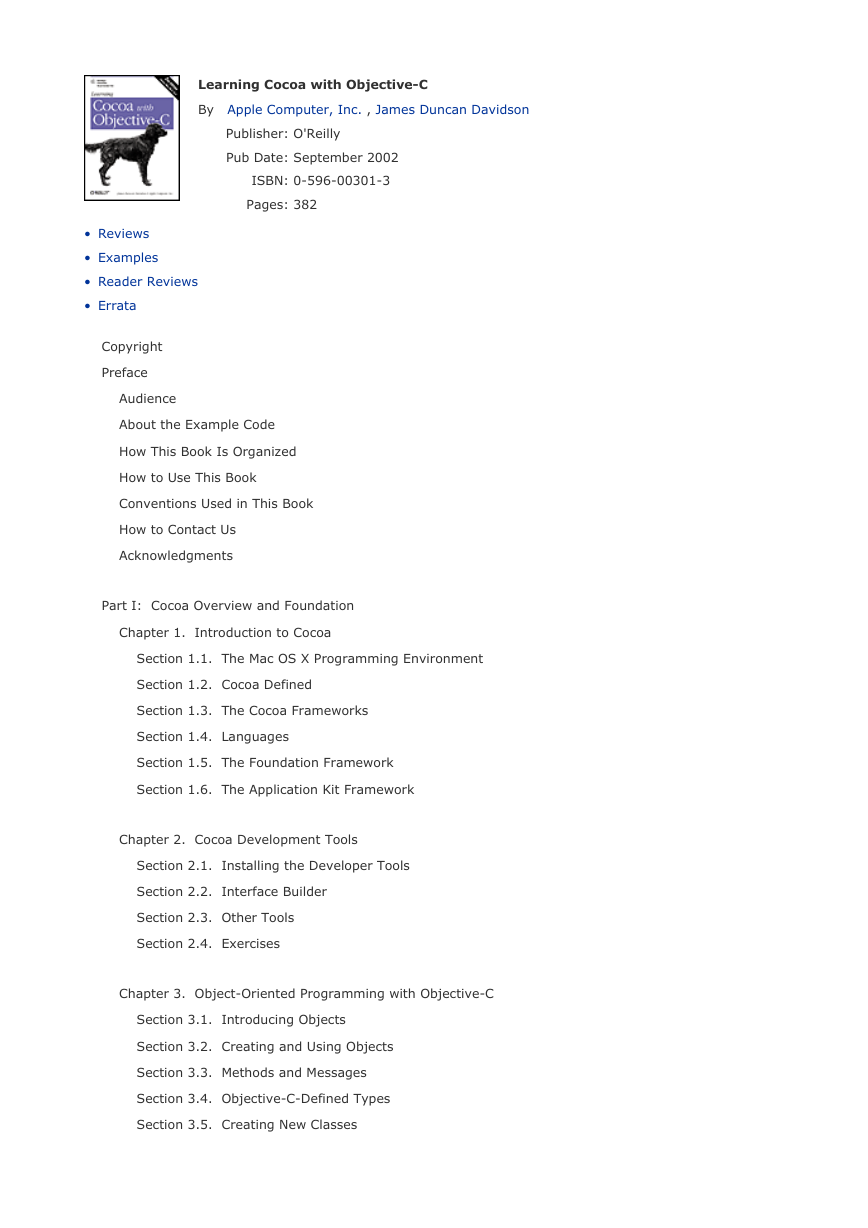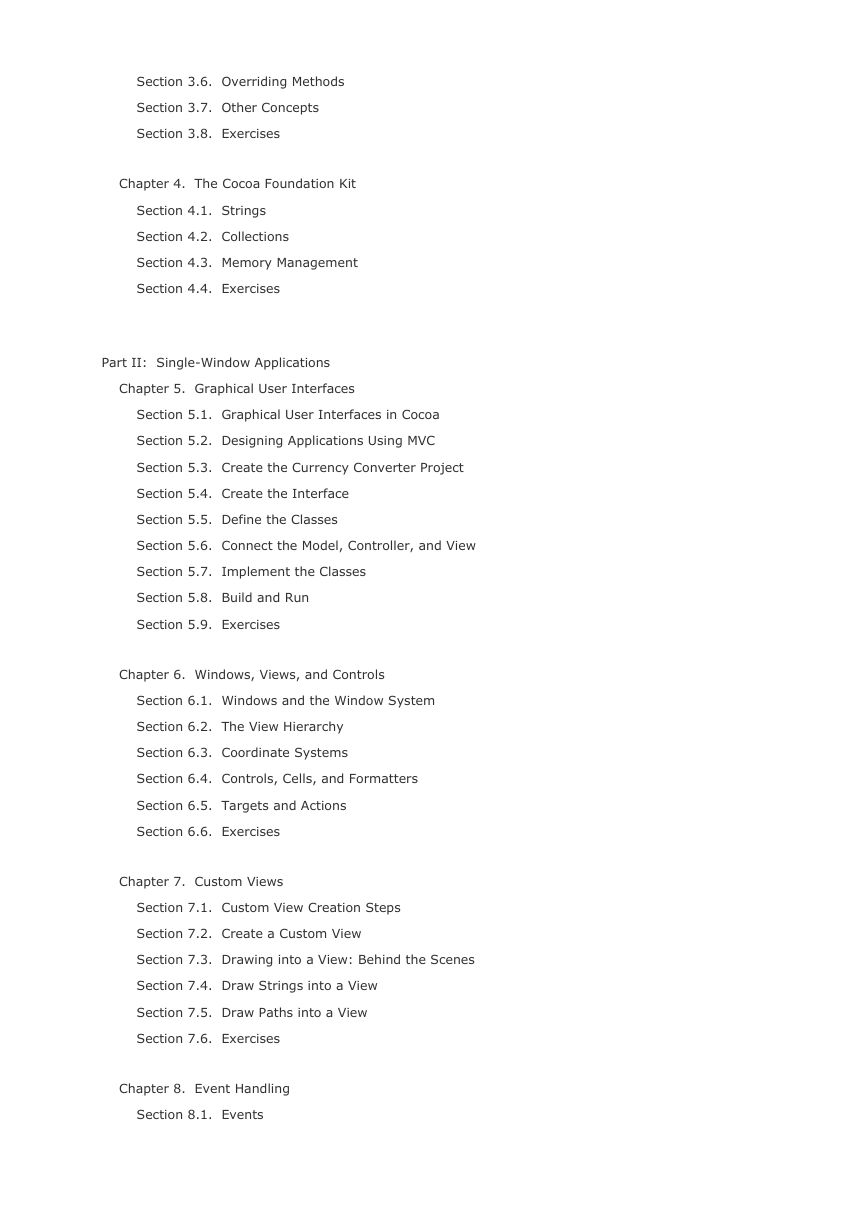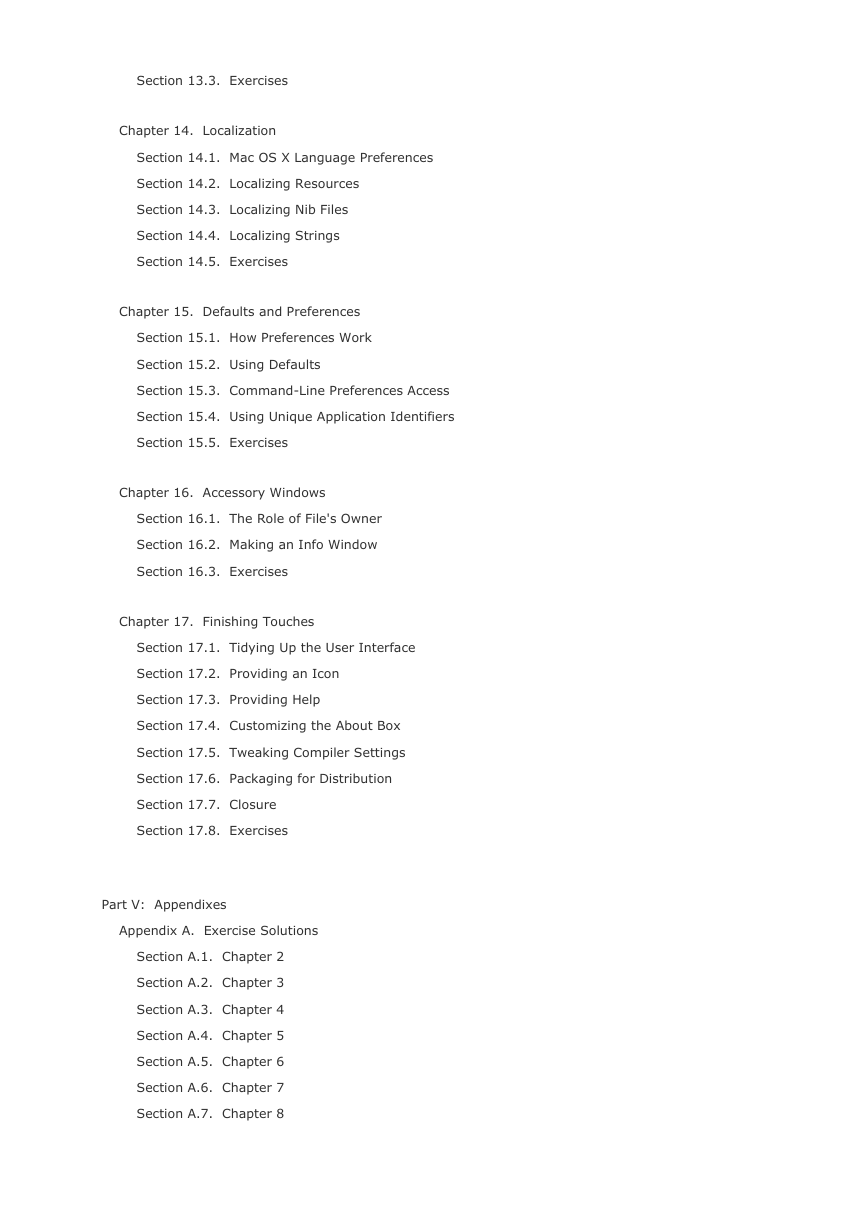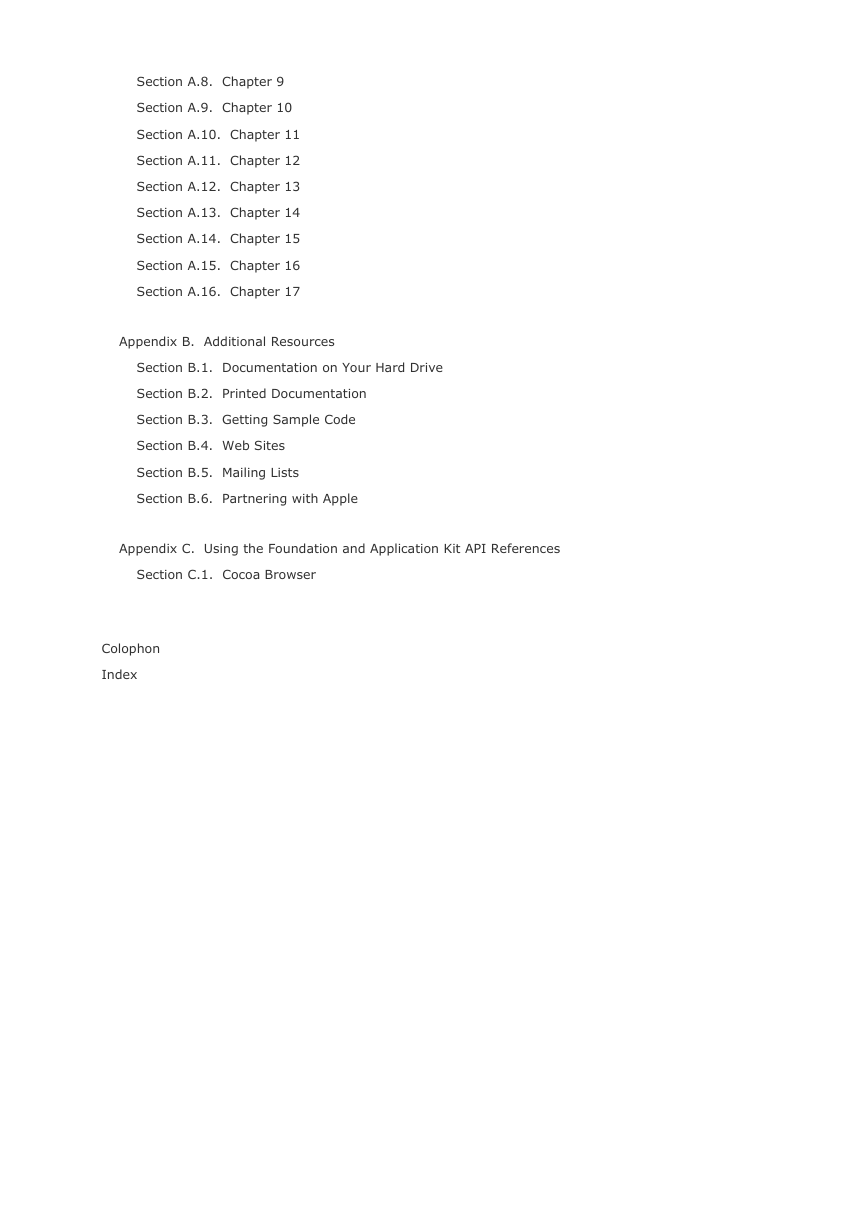Table of contents
Copyright
Preface
Audience
About the Example Code
How This Book Is Organized
How to Use This Book
Conventions Used in This Book
How to Contact Us
Acknowledgments
Part I: Cocoa Overview and Foundation
Chapter 1. Introduction to Cocoa
1.1 The Mac OS X Programming Environment
1.2 Cocoa Defined
1.3 The Cocoa Frameworks
1.4 Languages
1.5 The Foundation Framework
1.6 The Application Kit Framework
Chapter 2. Cocoa Development Tools
2.1 Installing the Developer Tools
2.2 Interface Builder
2.3 Other Tools
2.4 Exercises
Chapter 3. Object-Oriented Programming with Objective-C
3.1 Introducing Objects
3.2 Creating and Using Objects
3.3 Methods and Messages
3.4 Objective-C-Defined Types
3.5 Creating New Classes
3.6 Overriding Methods
3.7 Other Concepts
3.8 Exercises
Chapter 4. The Cocoa Foundation Kit
4.1 Strings
4.2 Collections
4.3 Memory Management
4.4 Exercises
Part II: Single-Window Applications
Chapter 5. Graphical User Interfaces
5.1 Graphical User Interfaces in Cocoa
5.2 Designing Applications Using MVC
5.3 Create the Currency Converter Project
5.4 Create the Interface
5.5 Define the Classes
5.6 Connect the Model, Controller, and View
5.7 Implement the Classes
5.8 Build and Run
5.9 Exercises
Chapter 6. Windows, Views, and Controls
6.1 Windows and the Window System
6.2 The View Hierarchy
6.3 Coordinate Systems
6.4 Controls, Cells, and Formatters
6.5 Targets and Actions
6.6 Exercises
Chapter 7. Custom Views
7.1 Custom View Creation Steps
7.2 Create a Custom View
7.3 Drawing into a View: Behind the Scenes
7.4 Draw Strings into a View
7.5 Draw Paths into a View
7.6 Exercises
Chapter 8. Event Handling
8.1 Events
8.2 Dot View Application
8.3 Event Delegation
8.4 Notifications
8.5 Exercises
Chapter 9. Models and Data Functionality
9.1 Protocols
9.2 Key-Value Coding
9.3 Table Views
9.4 Table View Example
9.5 Saving Data: Coding and Archiving
9.6 Using Formatters
9.7 Sorting Tables
9.8 Exercises
Part III: Document-Based Applications
Chapter 10. Multiple Document Architecture
10.1 Architectural Overview
10.2 Building a Document-Based Application
10.3 Exercises
Chapter 11. Rich-Text Handling
11.1 Cocoa's Text System
11.2 Creating a Rich-Text Editor
11.3 Enabling the Font Menu
11.4 Text Storage and Attributed Text
11.5 Enabling the Text Menu
11.6 Handling Embedded Images
11.7 Exercises
Part IV: Miscellaneous Topics
Chapter 12. Printing
12.1 Printing a View
12.2 Using Print Operations
12.3 Setting Margins
12.4 Exercises
Chapter 13. Bundles and Resources
13.1 Peeking Inside Bundles
13.2 Using Bundles
13.3 Exercises
Chapter 14. Localization
14.1 Mac OS X Language Preferences
14.2 Localizing Resources
14.3 Localizing Nib Files
14.4 Localizing Strings
14.5 Exercises
Chapter 15. Defaults and Preferences
15.1 How Preferences Work
15.2 Using Defaults
15.3 Command-Line Preferences Access
15.4 Using Unique Application Identifiers
15.5 Exercises
Chapter 16. Accessory Windows
16.1 The Role of File's Owner
16.2 Making an Info Window
16.3 Exercises
Chapter 17. Finishing Touches
17.1 Tidying Up the User Interface
17.2 Providing an Icon
17.3 Providing Help
17.4 Customizing the About Box
17.5 Tweaking Compiler Settings
17.6 Packaging for Distribution
17.7 Closure
17.8 Exercises
Part V: Appendixes
Appendix A. Exercise Solutions
A.1 Chapter 2
A.2 Chapter 3
A.3 Chapter 4
A.4 Chapter 5
A.5 Chapter 6
A.6 Chapter 7
A.7 Chapter 8
A.8 Chapter 9
A.9 Chapter 10
A.10 Chapter 11
A.11 Chapter 12
A.12 Chapter 13
A.13 Chapter 14
A.14 Chapter 15
A.15 Chapter 16
A.16 Chapter 17
Appendix B. Additional Resources
B.1 Documentation on Your Hard Drive
B.2 Printed Documentation
B.3 Getting Sample Code
B.4 Web Sites
B.5 Mailing Lists
B.6 Partnering with Apple
Appendix C. Using the Foundation and Application Kit API References
C.1 Cocoa Browser
Colophon
Index
















 2023年江西萍乡中考道德与法治真题及答案.doc
2023年江西萍乡中考道德与法治真题及答案.doc 2012年重庆南川中考生物真题及答案.doc
2012年重庆南川中考生物真题及答案.doc 2013年江西师范大学地理学综合及文艺理论基础考研真题.doc
2013年江西师范大学地理学综合及文艺理论基础考研真题.doc 2020年四川甘孜小升初语文真题及答案I卷.doc
2020年四川甘孜小升初语文真题及答案I卷.doc 2020年注册岩土工程师专业基础考试真题及答案.doc
2020年注册岩土工程师专业基础考试真题及答案.doc 2023-2024学年福建省厦门市九年级上学期数学月考试题及答案.doc
2023-2024学年福建省厦门市九年级上学期数学月考试题及答案.doc 2021-2022学年辽宁省沈阳市大东区九年级上学期语文期末试题及答案.doc
2021-2022学年辽宁省沈阳市大东区九年级上学期语文期末试题及答案.doc 2022-2023学年北京东城区初三第一学期物理期末试卷及答案.doc
2022-2023学年北京东城区初三第一学期物理期末试卷及答案.doc 2018上半年江西教师资格初中地理学科知识与教学能力真题及答案.doc
2018上半年江西教师资格初中地理学科知识与教学能力真题及答案.doc 2012年河北国家公务员申论考试真题及答案-省级.doc
2012年河北国家公务员申论考试真题及答案-省级.doc 2020-2021学年江苏省扬州市江都区邵樊片九年级上学期数学第一次质量检测试题及答案.doc
2020-2021学年江苏省扬州市江都区邵樊片九年级上学期数学第一次质量检测试题及答案.doc 2022下半年黑龙江教师资格证中学综合素质真题及答案.doc
2022下半年黑龙江教师资格证中学综合素质真题及答案.doc